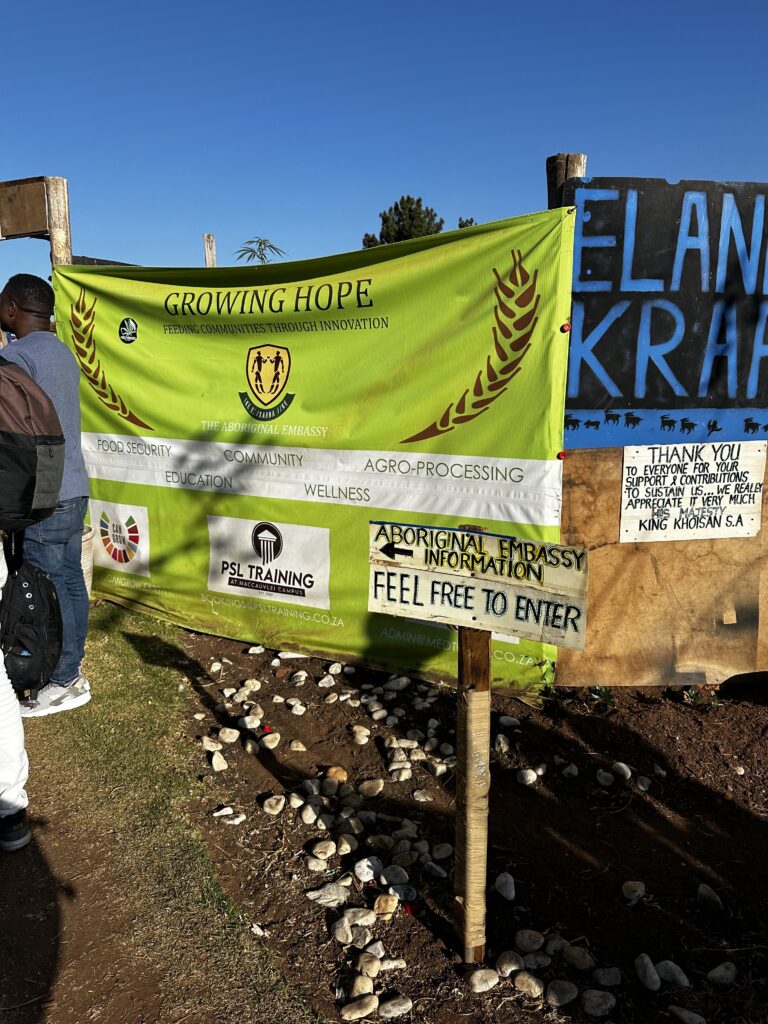By Columbo Amedekanya, Pedro de Melo, and Onthatile Msweli
The moment we stepped into the courtyard of the Khoisan King, we realized we were entering a world far removed from the bustling urban life we were accustomed to. The scene before us was a vivid tableau of tradition, simplicity, and a deep connection to the earth.
The king’s nephew, our guide and interpreter, greeted us dressed in traditional attire – a wool and animal skin headband shaped like a triangle, with more animal skin covering his groin area. Across his chest hung a handmade cross-body bag, also fashioned from animal hide. His appearance immediately set the tone for our encounter, transporting us to a realm where ancient customs still thrive.

Behind him, a kraal (an enclosure made of thorn-bush branches) bustled with life. Chickens – hens, roosters, and chicks – roamed freely, their clucking providing a constant backdrop. A vegetable garden and several huts housing the king’s immediate family completed the scene. The sounds of laughter from the youth, an occasional baby’s cry, and call-and-response exchanges between family members created an atmosphere of vibrant community life.
Our guide welcomed us in the Khoisan language, a fascinating tongue punctuated by distinctive clicking sounds. He then taught us the proper way to greet the king – a gesture involving crossing our arms across our chests and uttering a word in their language. This brief lesson in etiquette instilled in us a sense of respect and humility even before meeting the monarch.
When the king emerged, his presence was both commanding and welcoming. Dressed in traditional attire that stood out starkly against modern clothing, he walked barefoot – a powerful symbol of his connection to the earth and his cultural heritage. Despite the initial sense of intimidation his unique appearance might evoke, his warm smile and gentle demeanor quickly put us at ease.
As we conversed, the king’s wisdom and extensive knowledge became evident. His humility was striking, and he treated everyone with profound respect, regardless of their status. This encounter challenges our preconceptions about wealth and happiness. While an outsider might view the apparent material simplicity of the community with pity, we found ourselves questioning whether poverty should automatically be associated with suffering or unhappiness.

The king and his people seemed to embody a richness of spirit, culture, and knowledge that transcended material possessions. Their greatest strengths, as became clear through our conversation, were their gentleness, humility, and above all, their hope. Hope that one day their story will be heard, that their people will be recognized as another vibrant hue in the rainbow of South African society.
As we left the king’s presence, we felt profoundly moved and inspired by the resilience of the Khoisan people. This encounter served as a powerful reminder that true wealth and fulfillment often lie beyond material possessions, in the strength of community, the preservation of culture, and the enduring power of hope.
In an increasingly modernized world, the Khoisan king and his people stand as a testament to the value of maintaining connections to our roots, to the earth, and to each other. Their way of life challenges us to reconsider our definitions of progress and prosperity, offering a different perspective on what it means to live a rich and meaningful life.
